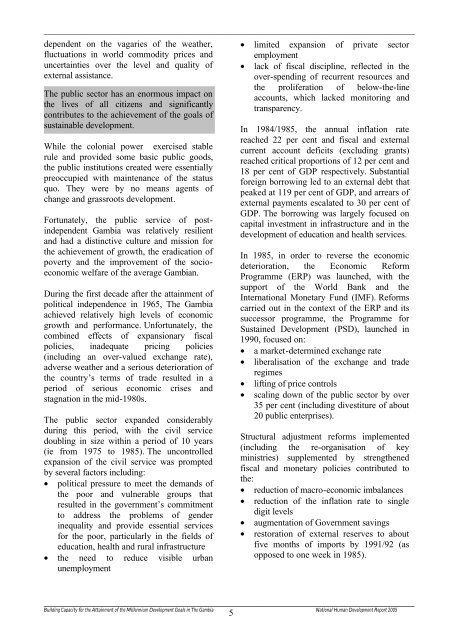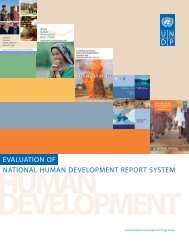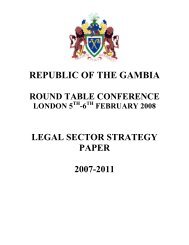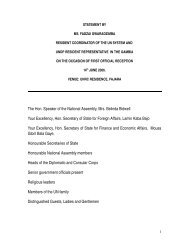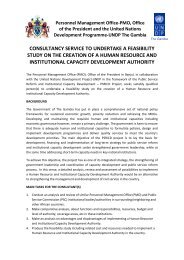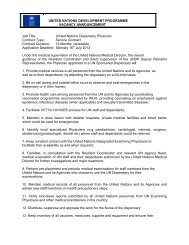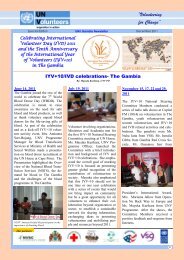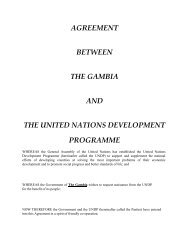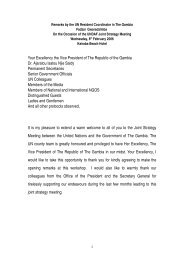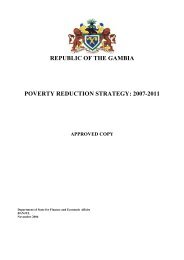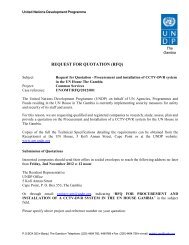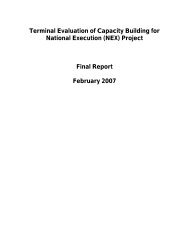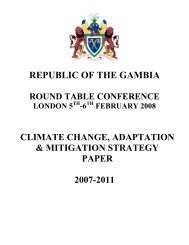Introduction - UNDP The Gambia
Introduction - UNDP The Gambia
Introduction - UNDP The Gambia
Create successful ePaper yourself
Turn your PDF publications into a flip-book with our unique Google optimized e-Paper software.
________________________________________________________________________________________________________________________<br />
dependent on the vagaries of the weather,<br />
fluctuations in world commodity prices and<br />
uncertainties over the level and quality of<br />
external assistance.<br />
<strong>The</strong> public sector has an enormous impact on<br />
the lives of all citizens and significantly<br />
contributes to the achievement of the goals of<br />
sustainable development.<br />
While the colonial power exercised stable<br />
rule and provided some basic public goods,<br />
the public institutions created were essentially<br />
preoccupied with maintenance of the status<br />
quo. <strong>The</strong>y were by no means agents of<br />
change and grassroots development.<br />
Fortunately, the public service of postindependent<br />
<strong>Gambia</strong> was relatively resilient<br />
and had a distinctive culture and mission for<br />
the achievement of growth, the eradication of<br />
poverty and the improvement of the socioeconomic<br />
welfare of the average <strong>Gambia</strong>n.<br />
During the first decade after the attainment of<br />
political independence in 1965, <strong>The</strong> <strong>Gambia</strong><br />
achieved relatively high levels of economic<br />
growth and performance. Unfortunately, the<br />
combined effects of expansionary fiscal<br />
policies, inadequate pricing policies<br />
(including an over-valued exchange rate),<br />
adverse weather and a serious deterioration of<br />
the country’s terms of trade resulted in a<br />
period of serious economic crises and<br />
stagnation in the mid-1980s.<br />
<strong>The</strong> public sector expanded considerably<br />
during this period, with the civil service<br />
doubling in size within a period of 10 years<br />
(ie from 1975 to 1985). <strong>The</strong> uncontrolled<br />
expansion of the civil service was prompted<br />
by several factors including:<br />
• political pressure to meet the demands of<br />
the poor and vulnerable groups that<br />
resulted in the government’s commitment<br />
to address the problems of gender<br />
inequality and provide essential services<br />
for the poor, particularly in the fields of<br />
education, health and rural infrastructure<br />
• the need to reduce visible urban<br />
unemployment<br />
• limited expansion of private sector<br />
employment<br />
• lack of fiscal discipline, reflected in the<br />
over-spending of recurrent resources and<br />
the proliferation of below-the-line<br />
accounts, which lacked monitoring and<br />
transparency.<br />
In 1984/1985, the annual inflation rate<br />
reached 22 per cent and fiscal and external<br />
current account deficits (excluding grants)<br />
reached critical proportions of 12 per cent and<br />
18 per cent of GDP respectively. Substantial<br />
foreign borrowing led to an external debt that<br />
peaked at 119 per cent of GDP, and arrears of<br />
external payments escalated to 30 per cent of<br />
GDP. <strong>The</strong> borrowing was largely focused on<br />
capital investment in infrastructure and in the<br />
development of education and health services.<br />
In 1985, in order to reverse the economic<br />
deterioration, the Economic Reform<br />
Programme (ERP) was launched, with the<br />
support of the World Bank and the<br />
International Monetary Fund (IMF). Reforms<br />
carried out in the context of the ERP and its<br />
successor programme, the Programme for<br />
Sustained Development (PSD), launched in<br />
1990, focused on:<br />
• a market-determined exchange rate<br />
• liberalisation of the exchange and trade<br />
regimes<br />
• lifting of price controls<br />
• scaling down of the public sector by over<br />
35 per cent (including divestiture of about<br />
20 public enterprises).<br />
Structural adjustment reforms implemented<br />
(including the re-organisation of key<br />
ministries) supplemented by strengthened<br />
fiscal and monetary policies contributed to<br />
the:<br />
• reduction of macro-economic imbalances<br />
• reduction of the inflation rate to single<br />
digit levels<br />
• augmentation of Government savings<br />
• restoration of external reserves to about<br />
five months of imports by 1991/92 (as<br />
opposed to one week in 1985).<br />
________________________________________________________________________________________________<br />
Building Capacity for the Attainment of the Millennium Development Goals in <strong>The</strong> <strong>Gambia</strong> National Human Development Report 2005<br />
5


